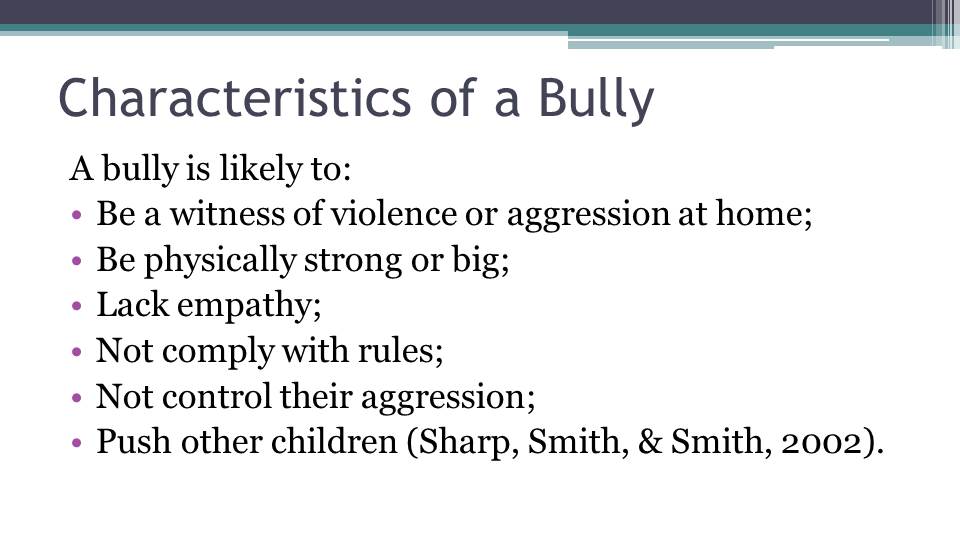The Concept of Bullying
- Bullying is a concept which describes a broad set of aggressive behaviors ranging from ridicule to violence (Brown, 2008, p. 101).
- More than two-thirds of children and adolescents experience bullying, and more than one-fourth of them report extreme forms of coercion (Brown, 2008, p. 101).
In the recent years, there has been a lot of controversy regarding bullying. More than two-thirds of children and adolescents experience bullying and more than one-fourth of them report extreme forms of coercion (Brown, 2008, p. 101). Such statistics necessitates the understanding of the concept of bullying in order to develop prevention strategies.
Bullying is a concept which describes a broad set of aggressive behaviors ranging from ridicule to violence (Brown, 2008, p. 101). The concept of bullying implies power imbalance between a bully and a victim, since the victim is unable to defend themselves (Brown, 2008, p. 101). Some scholars regard bullying as “junior version of hate-crimes” (Gerstenfeld, 2013, p. 124).

Manifestations of bullying
Bullying:
- Verbal abuse;
- Physical abuse;
- Blaming;
- Gossiping;
- Invalid Criticism;
- Social isolation.
Bullying may take different forms. These include:
- Verbal abuse, such as ridiculing a victim, name-calling or threatening them;
- Physical abuse, such as touching, slapping, kicking the victim, or taking belongings;
- Blaming without any factual grounds;
- Gossiping;
- Invalid or unwarranted criticism;
- Social isolation, including “silent treatment”, sitting at a separate table in a cafeteria, etc.
Bullying most typically occurs at the playground, since it is least supervised. However, bullying may also occur in classrooms, corridors and other locations (Sharp, Smith, & Smith, 2002, p. 7).

How is Bullying Accomplished
Places where Bullying Occurs:
- Classroom;
- Corridor;
- Hallway;
- Playground;
- Toilet.
Typically bullying occurs in those places where there is no adult supervision. Bullying most typically occurs at the playground or in the toilet, since it is least supervised. However, bullying may also occur in classrooms, corridors and other locations (Sharp, Smith, & Smith, 2002, p. 7).
Bullying occurs in those times when there are no adults around. When adults are present, bullies are morel likely to “act normal” in order to avoid punishment.

Characteristics of a Bully
A bully is likely to:
- Be a witness of violence or aggression at home;
- Be physically strong or big;
- Lack empathy;
- Not comply with rules;
- Not control their aggression;
- Push other children (Sharp, Smith, & Smith, 2002).
Several characteristics of a student’s behavior are likely to suggest that they are bullying other students. A bully is likely to:
- Be a witness of violence or aggression at home;
- Be physically strong or big;
- Lack empathy;
- Not comply with rules;
- Not control their aggression;
- Push other children (Sharp, Smith, & Smith, 2002).
School can use these characteristics to identify a bully or a grounp engaged in bullying. Due to the abovementioned characteristics, bullies are likely to present a problem to society in future. They are more likely to be involved in fights later in life, have problems with law, drop out of the university or have a problem finding a job due to their inability to control aggression.

Consequences of Bullying
- Bullying makes victims feel afraid and marginalized (Gerstenfeld, 2013, p. 123);
- Bullying may affect mental health of the victim, contribute to self-harm or suicide (Gerstenfeld, 2013, p. 123);
- Victims of bullying have lower self-esteem and have trust issues (Sharp, Smith, & Smith, 2002, p. 7);
- Due to stress, victims of bullying may not perform well academically (Sharp, Smith, & Smith, 2002, p. 7).
Research suggests that bullying has several immediate and long-term consequences:
- Bullying makes victims feel afraid and marginalized (Gerstenfeld, 2013, p. 123);
- Bullying may affect mental health of the victim, contribute to self-harm or suicide (Gerstenfeld, 2013, p. 123);
- Victims of bullying have lower self-esteem and have trust issues (Sharp, Smith, & Smith, 2002, p. 7);
- Due to stress, victims of bullying may not perform well academically (Sharp, Smith, & Smith, 2002, p. 7).

The Prevention of Bullying Activities
No bullying:
- Deterrence;
- Surveillance;
- Raising Awareness;
- School-based Consultation;
- Promoting Equality and Diversity.
Schools have the authority and responsibility to stop bullying. Following strategies are proposed to minimize the chances of bullying:
- Deterrence: disciplinary policies and regulations. Zero-tolerance disciplinary policies and regulations are needed to minimize the rates of various offenses and promote responsible behavior.
- Surveillance: security cameras, security guards. Surveillance can be used to effectively address the issue of school safety.
- Raising Awareness: raising awareness about the consequences of bullying.
- School-based consultation: individual and classwide counseling. Both individual and classwide counseling programs which address aggressive behavior can be used to reduce such behavior. Individual counseling could be used to let students speak out.
- Promoting Equality and Diversity: Creating a safe and engaging learning environment by embracing diversity and establishing culturally competent teaching practices.

References
Brown, J. (2008). What Is Bullying? Journal of Adolescent Health, 43, 101-102.
Gerstenfeld, P. (2013). Hate Crimes: Causes, Controls, and Controversies. London, United Kingdom: SAGE Publications.
Sharp, S., Smith, P., & Smith, P. (2002). School Bullying: Insights and Perspectives. Abingdon, United Kingdom: Routledge.